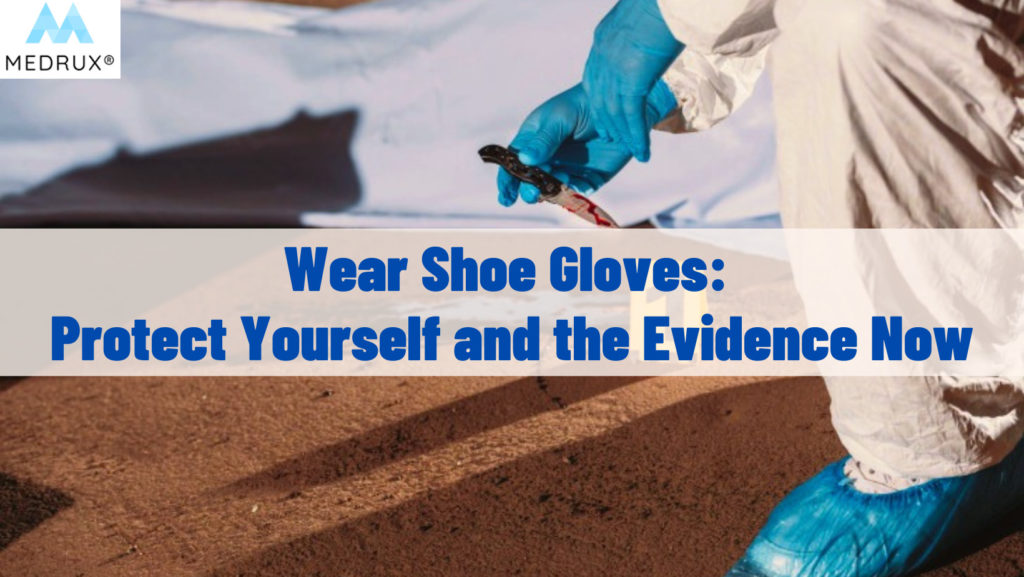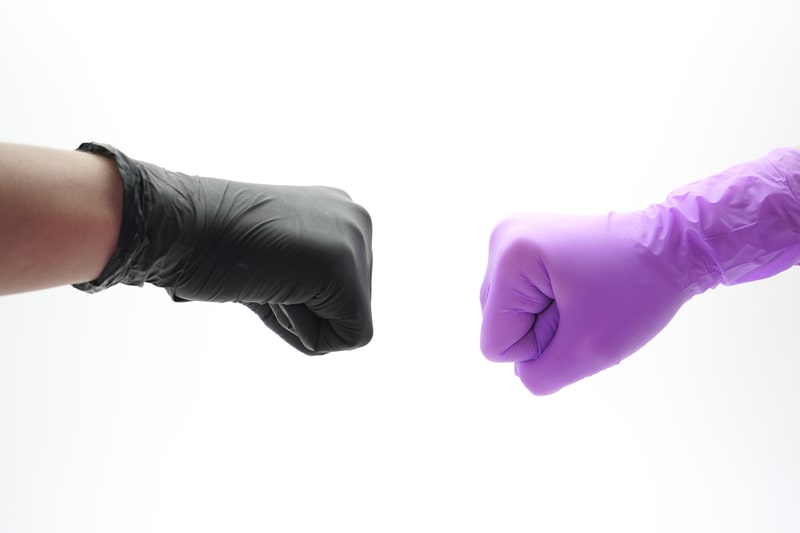Most people who wear gloves do so to give themselves some protection.
Protection from the elements—cold or hot; dirt and infection; chemicals; protection for whatever they would be handling, such as a person or a surface made of precious metal; and protection from being caught when doing crime.
“Every contact leaves a trace.”
Law enforcement personnel and crime scene technicians must take special precautions when gathering and handling evidence tainted with blood or other bodily fluids because these fluids are more likely than not to contain infectious organisms linked to diseases like AIDS, hepatitis B, and tuberculosis.
Full-body, disposable protective clothing that covers the wrists, ankles, and head is the first step in ensuring adequate protection.
Booties, usually referred to as protective shoe covers, are the following. These keep shoes clean and clear of toxins at the scene and are worn over top of shoes.
The best defense is disposable gloves. Shoe covers should also be taken into consideration.
This article will cover the following points:
- History of the first use of fingerprints
- Reasons for wearing gloves: Protect yourself
- Reasons for wearing gloves: Protect the evidence
- Material for crime scene gloves
- Footwear impressions
- The Need for wearing shoe gloves at crime scenes
History of the first use of fingerprints
Have you heard fingerprints were first used in the criminal investigation in the seventh century? Using fingerprints as a form of identification was first developed in the seventh century. (1)
Thomas Jennings escaped from a murder scene using a newly painted railing, but unknowingly he left behind something that would forever transform detective work.
Police claimed they could identify the burglar by photographing and removing the railing.
They were correct, in the eyes of the court; Hiller’s murder would result in the first conviction in a criminal trial using fingerprint evidence in the United States. This was the first criminal trial that used fingerprints as evidence. (2)
Paul Leland Kirk—biochemist and criminalist—expressed the principle of the presence of evidence of every touch.
“Wherever he steps, whatever he touches, whatever he leaves, even unconsciously, will serve as a silent witness against him.
Not only his fingerprints or his footprints but his hair, the fibers from his clothes, the glass he breaks, the tool mark he leaves, the paint he scratches, and the blood or semen he deposits or collects.
All of these and more bear mute witness against him. This is evidence that does not forget. It is not confused by the excitement of the moment.
Physical evidence cannot be wrong, it cannot perjure itself, and it cannot be wholly absent. Only human failure to find it, study and understand it, can diminish its value.” (3)
Bottom line:
Fingerprints for criminal investigation were used long ago to determine who committed a murder.
Reasons for wearing gloves: Protect Yourself.
Sadly, contamination commonly happens when obtaining evidence from crime scenes.
Disposable gloves that provide barrier protection are, therefore, crucial. Let’s examine how forensics and evidence-gathering gloves can safeguard crime scene investigators and the collected evidence.
There are often broken glass pieces and sharp instruments nearby where a crime was committed.
Numerous objects at crime scenes could also be stained with blood or other human fluids. You could catch a disease or an infection if you come into contact these fluids.
Wearing gloves while processing a crime scene is essential to protect yourself from biohazardous substances.
Most people need to be made aware of what biohazards are. This includes anything physical that risks the health of people and animals. The words biological and hazard are combined to form the phrase biohazard.
-
Blood
Blood is the most common biohazard found at crime scenes.
Numerous things are covered in blood, including the carpet, fissures in the walls, furniture, and more. Human feces are among the additional dangers discovered at crime sites.
Blood is the primary source of infection. When inspecting the crime scene, investigators should also look for sharp objects like hypodermic needles.
Wearing two sets of gloves gives you additional defense against punctures from objects like glass, needles, and metal pieces, as well as contact with human fluids.
-
Odors
Numerous unpleasant smells can be found at most crime scenes. Crime scene investigators struggle to describe the disgusting smell that a dead body emits.
That’s why wearing personnel protective equipment masks and respirators is necessary to assist in filtering out odor and any contaminants in the air.
Protective measures should be taken to avoid contact with potentially infectious materials.
When gloves are ripped, pierced, or lose their barrier-forming effectiveness, they should be replaced. Wear the proper eye and face protection to protect yourself against splashes, sprays, and spatters of potentially contagious materials.
Remove gloves and other personal protective equipment to avoid contaminating vulnerable skin or clothing.
After taking off gloves or other personal protective equipment, wash your hands.
Wherever human blood, bodily fluids, or other potentially contagious elements are present, it is forbidden to eat, drink, smoke, or apply cosmetics—no matter whether one is wearing personal protection.
Place contaminated sharps in the proper closeable, leak-proof, puncture-resistant containers when transported or stored. The containers should be marked with a BIOHAZARD warning label.
Never handle contaminated needles or sharp objects by bending, re-capping, removing, or any other way.
Bottom line:
It is a must that crime scene investigators should wear gloves to safeguard themselves from contracting infectious diseases.
Reasons for wearing gloves: Protect the Evidence.
There are often broken glass pieces and sharp instruments nearby where a crime was committed.
Cutting yourself on this substance would contaminate the scene with your blood and Deoxyribonucleic Acid (DNA), making it more challenging to find the actual offender.
Some evidence is easily disposed of.
The evidence found at crime scenes is often exceedingly delicate, including fingerprints. Without protective gloves, you could easily ruin them if you touched them.
Appropriate gloves can often make a significant difference in your ability to acquire sufficient evidence to support your case. After all, the gathering of forensic evidence has helped solve several high-profile cases.
Bottom line:
It is a must that crime scene investigators should wear gloves to avoid contamination of the crime scenes.
Material for Crime Scene Gloves
Gloved hands carry dirt, dust, and other things. Additionally, they can still have traces of common crime scene elements like blood or other bodily fluids.
Rubber or latex gloves should be taped at the wrist, followed by a giant pair of rubber gloves to ensure enhanced protection.
When gloved hands touch other surfaces, they leave traces or impressions. These are favorable perceptions. When a gloved hand wipes away dirt, blood, or other materials from a surface, negative images may also result.
Even an hour into wearing polymer (nitrile and vinyl) gloves, there is still no transfer of fingermark residues. (1)
After an hour, it was discovered that clean cotton gloves had some signs of permeability, but they were more resistant to the transfer of contamination from joint touch surfaces.
There are many factors to remember when choosing suitable crime scene gloves.
Your gloves should not contain any powder. The powder in the gloves can adhere to the DNA you collect and prevent it from being extracted and analyzed. Likewise, if you are allergic to latex, pick nitrile gloves instead.
You want to ensure that the gloves you choose have superior tear and puncture resistance. This will help ensure that they are not compromised while handling evidence.
Additionally, it would be best to search for gloves with strong barrier protection that won’t absorb liquids or chemicals.
Your bodily fluids won’t taint the evidence, and you’ll be shielded from any possibly hazardous compounds.
Last but not least, you want to be sure that the gloves you select are cozy. It will be easier to concentrate on gathering evidence if you wear comfortable gloves.
Bottom line:
Crime scene gloves should carry special features. They should have superior tear and puncture resistance. They should also be comfortable with easier handling of evidence at crime scenes.
Footwear Impressions
Any crime scene is likely to contain impressions and marks.
Impressions can come from a variety of sources. Nearly all sorts of crime scenes contain evidence of foot and shoe prints.
The impressions left by footwear are the most prevalent and thoroughly researched types of impressions. A shoe’s presence at a crime scene can be demonstrated in court using forensic footwear evidence.
The most prevalent type of evidence at a crime scene is frequently footwear, which can occasionally be just as specific as a fingerprint.
Tool marks, tire markings, and fabric impressions are additional sources of imprints. An example of a fabric print is the impression or print of a glove.
Numerous studies have examined sex, stature estimation, and personal identification using shoe impressions. A person’s foot and shoe sizes can be used to determine their height.
Footwear evidence can come in at least three forms, footwear outsole impressions, footwear insole impressions, and footwear trace evidence.
Footwear outsole impressions are marks left on a surface by touching a pair of shoes.
These can be dropped by people walking over them, kicked or stomped on, left on doors or walls by people trying to climb over them, dropped on others after being kicked or stomped on, or even dropped on other people after being stepped on.
On various surfaces, including carpet, concrete, and floor tiles, there may also be latent impressions that are difficult for the human eye to see.
Additional specialized light sources, like portable UV lights, may be needed for detection. In most cases, recovery entails taking photos and using “gel” or “electrostatic” dust lifters to remove the debris.
Footwear insole imprints are prints of a person’s feet on the insole (inside) of shoes.
Regardless of whether socks or another covering covers the wearer’s foot, the insole impression can still be left due to the sweat and grime from the foot.
You can tell if someone has worn a pair of shoes by the size and pattern of their foot and toe prints. The field of forensic podiatry includes the comparison and analysis of foot impressions.
The insole will display a digital representation of the wearer’s foot’s naked footprint. This can be compared to the shoe owner’s actual barefoot print to find a match.
Footwear trace evidence is traces of evidence that were found in shoes.
Trace evidence can be found in skin, glass shards, body hair, carpet or clothing fibers, soil particles, dust, and bodily fluids.
A shoe could be connected to a place or owner through the analysis of this trace evidence. DNA may be one of the components of forensic shoe evidence.
Footwear impressions might disclose information that forensic investigators may find helpful. The following details could be learned through an examination of the impressions at a crime scene:
Proving the presence of the number of people at a crime scene: Different footwear impressions at a crime scene will show more if more than one person was present.
Estimating the height of the wearer: A statistical correlation has been found between the wearer’s height and stride length, as well as the approximate size of their footwear.
Knowing the wearer’s activity at the time of the impression:
The impression of plastic shoes on soft surfaces can show whether a person was running, strolling, or carrying a heavy burden at the time the impression was taken.
Running makes deeper impressions more pronounced in the heel and toe areas. A person carrying a big load, like a body, will leave more profound imprints than when not doing so.
Estimating the shoes’ model, size, and place of manufacture:
The design components (shapes, patterns, and arrangements) that make up the outsole design can be seen in a shoe’s impression.
These can be compared with a database of shoe outsoles to determine the specific type of footwear that left an impression. Knowing the brand of shoes that left an impression can help reduce the number of suspects and be used to connect the same offender to various crime scenes (s).
Establishing a connection between the appearance of a particular pair of shoes at the crime scene: It is possible to identify any links by contrasting the impressions left at the crime site with a specific pair of shoes found on a suspect.
Eventually, the outsoles of a pair of worn shoes will develop their irregular wear and tear. These unplanned traits will be particular to that shoe and may be visible in impressions of crime scenes.
Bottom line:
The impressions left by footwear can be used to detect the identity of a murderer.
The Need for Wearing Shoe Gloves at Crime Scenes
Booties can be worn over proper shoes to protect personal footwear from any risks on the scene.
On a crime scene, bare feet, sandals, and open-toed shoes are hazardous and can contaminate evidence while working.
When the investigator wears closed-toe shoes, they are protected from falling, rolling, or being pierced by the toes by heavy or sharp things. To prevent evidence contamination at the crime scene, it’s crucial to wear shoe covers as personal protective equipment.
Shoe coverings shield the floor from potentially infectious foot and shoe prints, blood splatter and fingerprints.
By covering their shoes, the investigator avoids bringing dirt or bacteria from the bottom of their boots into the scene.
Bottom line:
Crime scene investigators should wear shoe gloves as personal protective equipment.
Conclusion
When collecting and handling evidence contaminated with blood or other human fluids, law enforcement personnel and crime scene technicians must take extra measures because these fluids are more likely to include infectious organisms connected to diseases.
“Every contact leaves a trace.”
The most prevalent type of evidence at a crime scene is frequently footwear, which can occasionally be just as specific as a fingerprint. Therefore, wearing gloves and shoe gloves is necessary at crime scenes to protect yourself and the contamination of the evidence.







